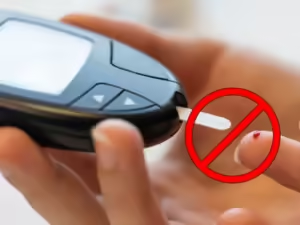
Is a CGM System Right for Your Diabetes Needs?

Always check your blood sugar levels to stay healthy and avoid problems. If you want to check your glucose levels in real-time, Continuous Glucose Monitoring (CGM) devices are better than the traditional finger-stick methods since they offer more data.
Table of Contents
Introduction
Some diabetics might not require a CGM suitability in the meantime. Reading this will enable you to decide whether a CGM device would fit your diabetes type. It addresses the advantages and disadvantages, who should take it, and the many types of diabetes can help with.
How Continuous Glucose Monitors Transform Diabetes Management?

Since Continuous Glucose Monitors (CGMs) reveal blood sugar readings in real time, the way diabetes is treated has altered. For those with type 1 and type 2 diabetes, diabetes management with CGM provides continual information and alarms to help them remain healthy and have better control.
Learn Continuous Glucose Monitors (CGM)

Day- and night-wise, a Continuous Glucose Monitor (CGM) constantly tracks your blood sugar levels. Unlike previous methods, a CGM does not take finger blood. Instead, it tells consumers their real-time glucose levels every few minutes and notifies them should their levels be either too high or too low. Benefit of the skin is a smartphone app or receiver showing the glucose levels; a small monitor serves as a transmitter sending data to a display device.
Regular knowledge intake enables people to control their blood sugar levels better. As we know it directs their decisions on insulin dosage, food, and degree of activity. CGM devices are perfect since they can identify fast changes in blood sugar levels that finger-prick testing would miss.
Who should use a CGM?

When you ask, who should use a CGM? several considerations come into play. Those who have type 1 or type 2 diabetes and need insulin or those whose blood sugar routinely decreases can find considerable advantages from CGM devices. A CGM improves glucose control, which lets you make immediate changes to lower your risk of problems.
Those who can sufficiently control their diabetes with food and drugs or those who do not have to monitor their condition regularly may not feel the money invested in a CGM is warranted. Those who find technology difficult or want to track their glucose more straightforwardly could also do finger-prick testing.
Should a CGM help diabetic insulin users

While some type 1 diabetics need insulin to stay healthy, others may find great advantages from a CGM system. The CGM notifies physicians of fluctuations in glucose levels, which directs their changes in insulin dosage. Combining an insulin pump with a continuous glucose monitor (CGM) helps those with type 1 diabetes perhaps have fewer diabetes-related problems and more consistent blood sugar levels.
Because they show variations in glucose levels, CGMs also allow for a more exact insulin dosage. This will help avoid either too high or too low blood sugar levels, lowering the risk of long-term conditions, including diabetes, vision, and heart disease. If one wishes less hypoglycemia and more control of their blood sugar, they use CGM for insulin-dependent diabetes.
Note: There might be affiliate links mentioned here. We may receive a commission if you purchase a product through an affiliate link. There is no additional charge for you. Please do your own research before making any online purchases.
Diabetes glucose monitoring without insulin

If you have diabetes and have to use insulin, a CGM is vital. Still, it helps others without insulin requirements as well. This is primarily true for those with type 2 diabetes who control their condition with drugs or lifestyle changes. In a professional setting, one regularly asked question is CGM for non-insulin-dependent diabetes. This will help them to control their diabetes more effectively.
A CGM helps someone with type 2 diabetes discover how their body responds to different diets or exercise programs. Some patients, especially those with reasonable control of their glucose levels with their present treatment, may only need some of the information a CGM offers.
Positive aspects of CGM machine application

A CGM device performs many times better than conventional methods of glucose level monitoring. First, it provides a more complete picture of variances in glucose levels, enabling more rapid changes in treatment. Second, daily finger-stick tests might not be able to spot trends and patterns CGMs help find. CGM devices, for example, can identify hypoglycemia brought on at night—a challenging condition for which there is no alternative approach. Those who find the previous methods bothersome or uncomfortable may also be more inclined to stay up with their glucose tracking.
Choosing the Best CGM for Your Need

The user will select the best CGM device according to their financial circumstances, manner of life, and requirements. Some CGM systems occasionally call for sensor adjustments. More complex devices that fit insulin pumps precisely abound and have alarms when blood sugar levels are too low or too high.
For someone with CGM for type 1 diabetes, the best choice may be running with an insulin pump. A smaller gadget checking glucose levels would be enough for someone with type 2 diabetes who does not need insulin. It would help if you considered the cost of the item and whether or not your insurance will pay for it. Also, consider how regular and easy daily living is.
Examining CGM’s advantages for Type 1 and Type 2 diabetes

Depending on their needs, someone with type 1 or type 2 diabetes could find a CGM helpful or inappropriate. Because it shows changes in glucose levels as they happen, a CGM helps type 1 diabetic daily insulin users better control their blood sugar.
With CGM for type 2 diabetes people can modify their insulin dosages and lower their risk of hypoglycemia. Type 2 diabetics without insulin should consider their diabetes control goals, hypoglycemia risk, and data comprehension before using a CGM. CGMs can manage blood sugar, reduce problems, and improve quality of life in all scenarios.
Conclusion
Give your health, way of life, and treatment goals significant attention before choosing a Continuous Glucose Monitoring (CGM) device for your diabetes. They can, for example, better control their glucose levels, have reduced hypoglycemia and get more customised diabetic treatment. Reasonably enough, weigh the benefits and disadvantages as well. Contact Weight Loss Teachers to find out if a CGM system suits your diabetes management needs effectively. According to our teachers you might have to wear the device continuously and learn how to use its data.
Disclaimer: The information provided in this article is for educational purposes only and should not be considered as a substitute for medical advice. Consult a healthcare professional before implementing any home remedies or making significant changes to your lifestyle.






